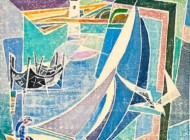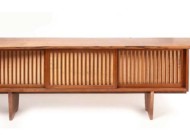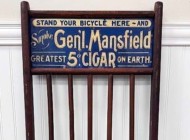
A Sioux quilled and beaded hide shirt, fourth quarter Nineteenth Century, led the sale’s first session, selling for $40,950.
Review by W.A. Demers, Photos Courtesy Hindman
CINCINNATI, OHIO — Hindman’s Native America art sale on April 21 offered early material of the Eastern Woodlands and Great Lakes, Nineteenth Century ledger art, weaponry, beadwork, historic and modern Puebloan pottery and paintings and ethnographic objects from the Arctic.
“I was pleased with the strong response to the April auction. I thought it was a beautiful sale and felt the prices reflected the objects we offered,” commented Danica Farnand, vice president and director of Native American art. “The market appears particularly strong for Southwestern material but the bidding for Plains material was also not without enthusiasm.”
A Sioux quilled and beaded hide shirt, fourth quarter Nineteenth Century, led the sale’s first session, selling for $40,950. Thread and sinew-sewn with brightly quilled panels on the sleeves, shoulders and bib, the shirt was further embellished with its bib surrounded by medium blue dark blue, and red white-heart beaded lanes. The shirt was enhanced with ermine tails wrapped with red wool and brown hair locks, blue and red pigment. With a 29-inch length, it measured a 40-inch chest.

A carved blackware pottery jar by Margaret Tafoya was designed with a wide band depicting Avanyu, a Tewa deity, the guardian of water. At a height of 17 inches, it made $11,340.
The same price was attained for a Fort Berthold quilled hide shirt from the fourth quarter of the Nineteenth Century. Thread-sewn, with plaited quillwork on hide strips in colors of orange, purple, red, teal and yellow, it featured a fringed bib with floral designs and long fringes hanging from its sleeves and chest.
San Ildefonso pottery is a staple of these sales, and a Maria and Julian Martinez (1887-1980 and 1885-1943) painted redware pottery plate, 1925-43, bearing a central image of a thunderbird went out at $37,800. It was signed on the base with a diameter of 14½ inches.
By Maria Martinez and her son Popovi Da (1923-1971), a redware plate was decorated with repeating feathers. It was dated May 1969, signed and dated on base with a diameter of 11½ inches and realized $11,340.
A carved blackware pottery jar by Margaret Tafoya (Santa Clara, 1904-2001) was designed with a wide band depicting Avanyu, a Tewa deity, the guardian of water, and was signed on base. At a height of 17 inches, it also made $11,340.

Among notable textiles in the sale, this Navajo Germantown pictorial weaving from the late Nineteenth Century, woven using seven colors to creating an eye-dazzling pattern of zigzagging diamonds with crosses and two male figures within, 83½ by 61½ inches, brought $13,860.
Avanyu was also the decorative motif for a Maria Martinez and Popovi Da blackware pottery jar with gunmetal finish. Dated July 1968 and 10 inches high, it crossed the block at $9,450.
Plains ledger art gave the ability to represent history for the Native American peoples of the Great Plains during the late Nineteenth and early Twentieth Centuries. With no written language in which to record their history, they did have a long tradition of preserving oral histories pictorially. For centuries, Plains men kept historical records of their tribes, first with petroglyphs and pictographs on rock walls, painted on buffalo hides or drawn in ledger books. One such example, an Arapaho drawing from the Edwards ledger book, third quarter of the Nineteenth Century, was bid to $25,200. It was a combat scene featuring the exploits of Two Arrows, who is denoted by the double arrow name glyph. In it he is depicted riding a palomino and wearing a capote, trade wool leggings and breechcloth; he holds a shield painted with a blue buffalo head framed with eagle feathers. In this image, Two Arrows is shown confronting a Pawnee warrior, who has his bow drawn and is dressed only in a breechcloth and black moccasins. Two Arrows’ shield is further illustrated on plate #38 of the same ledger, in the hands of another Arapaho warrior named Sitting Bull (not the famed Hunkpapa leader).
Used most predominantly by Eastern Woodland, Central and Northern Plains tribes in the Eighteenth and Nineteenth Centuries, a gunstock club was an Indigenous weapon used by many Native Americans, deriving its name from its similar appearance to the wooden stocks of muskets and rifles of the time. In this sale, fetching $23,940 was a Western Great Lakes gunstock club, with decorations from the mid-Nineteenth Century. With an overall length of 27 inches, it was decorated with four variously spoked circular elements, the depiction of a caterpillar and a stylized form of a Thunderbird on one side. The other side had a carved inset, steel blade and buffalo tail drop.

A Plains grizzly claw necklace crafted in the second half of the Nineteenth Century, its hide thong strung with blue “padre” beads and ten claws, realized $10,710.
Another weapon, a Western Plains tacked pipe tomahawk, fourth quarter of the Nineteenth Century, realized $13,860. It featured a hand-forged steel blade with an elongated bowl, a file-branded haft embellished with brass tacks, remnants of an original gasket and a piercing for attachment. Overall, its length was 23 inches with a blade length of 10½ inches and blade width of 3½ inches.
In the textiles category, the highest price was attained for a Navajo Germantown pictorial weaving from the late Nineteenth Century, woven using seven colors to creating an eye-dazzling pattern of zigzagging diamonds. Within this busy pattern were crosses and two male figures. Measuring 83½ by 61½ inches, it brought $13,860.
A Navajo late classic serape/rug from the fourth quarter of the Nineteenth Century was woven with single-ply indigo, cream and aniline red, and accented with three-ply moss green. Its design was vertical zigzagging bands with a central column of crosses. Measuring 75½ by 53¾ inches, it earned $12,600.
A matched pair of Sioux beaded hide possible bags, also from the fourth quarter of the Nineteenth Century, was each sinew-sewn and beaded using colors of medium blue, red white-heart, translucent green, deep blue and yellow. Each was 12 inches in length and 20 inches wide, and the pair left the gallery at $11,340.

Fetching $23,940 was a Western Great Lakes gunstock club with decorations from the mid-Nineteenth Century. With an overall length of 27 inches, it was decorated with four variously spoked circular elements, the depiction of a caterpillar and a stylized form of a Thunderbird on one side. The other side had a carved inset, steel blade and buffalo tail drop.
The same price was posted for a Nez Perce beaded boy’s shirt, fourth quarter Nineteenth Century. Colors on the thread-sewn red wool shirt with lanes of beadwork along shoulders and chest were medium and dark blue, greasy yellow, faceted deep translucent blue, pea green, white, pink and deep red white-heart; it was further decorated with ermine drops and green ribbon.
Also notable in the sale was a Plains grizzly claw necklace crafted in the second half of the Nineteenth Century. Its hide thong was strung with blue “padre” beads and ten claws; each claw had been coated with red pigment. It was 14 inches long and realized $10,710.
In addition, a Cheyenne beaded hide knife sheath, fourth quarter Nineteenth Century, 10 inches long, sold for $9,450, while an Imogene Big Medicine (Cheyenne, Twentieth/Twenty-First Century) beaded dress and boot moccasins with American flags earned $8,820.
Prices given include the buyer’s premium as stated by the auction house. For information, www.hindmanauctions.com or 513-871-1670.















